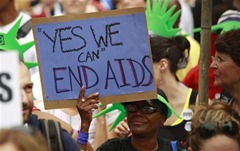AIDS activists take part in a rally across from the White House in Washington July 24, 2012. Credit: Reuters/Kevin Lamarque
By Susan Heavey
WASHINGTON | Fri Sep 28, 2012 2:56am EDT
(Reuters) - Patients stepping into Johns Hopkins University's HIV clinic in east Baltimore do not just see a doctor or get prescriptions for their antiretroviral drugs. Many also get help finding a place to live or bus fare to make it to their next appointment.
Such care that goes beyond the examination table and into patients' often challenging lives has been key to helping poorer HIV patients - particularly blacks and women - live long, healthier lives, according to a 15-year study published on Thursday in the journal Clinical Infectious Diseases.
Researchers at the university followed 6,366 patients in the mostly black, low-income part of a city marked by abandoned buildings and plagued by an illegal drug trade that drew national attention on the gritty television series "The Wire."
From 1995 to 2010, doctors at Hopkins joined with social workers and other experts to treat HIV, the human immunodeficiency virus that causes AIDs, and address other aspects of care that can often derail patients, such as being able to fill prescriptions or access health insurance programs for the needy.
They found that with additional assistance, patients at the clinic could expect to live to about age 73 despite their background. Researchers found no difference in patients' health over time despite their gender, race, risk group, or socioeconomic status - a finding they said showed comprehensive care could eliminate disparities that arise among at-risk groups.
"Just like over time we have developed medications that are easier to take, have fewer toxicities and are more effective, I think we've done exactly the same things in our ability to deliver quality care to this particular population," Dr. Richard Moore, the study's lead author, said in an interview.
Moore, a professor of infectious diseases and director of the university's clinic, said the program showed it was possible to counter the impact of economic disparities on healthcare.
Even though HIV medications have significantly improved since the virus emerged in the United States decades ago, accessing those medications, receiving consistent care and follow-up appointments for the chronic condition are key, he said.
HIV still hits certain populations harder than others, and rising infection rates among gay black men, for example, remain a major worry among public health experts.
IMPROVING OUTCOMES
"Our results emphasize that advances in HIV treatment have had a positive impact on all affected demographic and behavioral risk groups in an HIV clinical setting," Moore and his colleagues wrote.
Previous studies have shown that certain groups of HIV patients - the poor, minorities, women and drug users - tended to have worse outcomes and die earlier.
Moore found that more comprehensive care that addresses problems such as homelessness and a lack of reliable transportation could help an average 28-year-old with HIV live roughly 45 more years with no significantly higher risk of various infections or other complications, a result that "did not differ by demographic or behavioral risk group."
Moore also credited the roughly $2 billion Ryan White CARE Act, the largest federal program solely aimed at paying for care for low-income HIV patients who are uninsured or have inadequate coverage. The program, which President Barack Obama extended in 2009, is up for renewal next year.
About 92 percent of the clinic's patients are low-income, according to the study.
Michael Saag, head of the University of Alabama at Birmingham's Center for AIDS Research, said the new findings underscored the need to revamp the nation's healthcare system so that all people get quality care. HIV patients are lucky to have access to Ryan White funds, but others do not.
"This is likely a fundamental reason why the poor and disadvantaged in the United States have health disparities that cause disproportionately worse clinical outcomes than those with means," Saag said in an editorial accompanying the study.
To be sure, researchers only followed patients who continued with the clinic over time. Patients who dropped out for various reasons, even despite staff effort to contact them, were not included in the data.
Over the years, Moore said he and his colleagues had learned what tends to work, and what does not, when it comes to their patients.
Moore, who has worked at the Hopkins clinic for 24 years, said patients were immediately connected to a case worker who sometimes started counseling them even before their first appointment.
Other clinics have also started similar efforts in recent year, but this more comprehensive type of care is not yet available nationwide.
"Medical care, particularly for a lot of people who aren't necessarily well-insured or living in a stable situation, you have to just as much deal with all that aspect of assisting them with their lives," Moore said. "I wish that wasn't the case."
(Editing by Peter Cooney Steenhuysen)

No comments:
Post a Comment